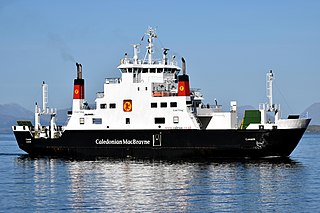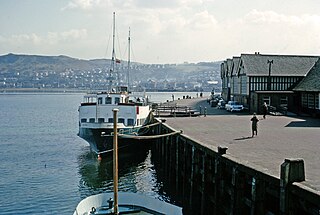Related Research Articles

Argyll and Bute is one of 32 unitary council areas in Scotland and a lieutenancy area. The current lord-lieutenant for Argyll and Bute is Jane Margaret MacLeod. The administrative centre for the council area is in Lochgilphead at Kilmory Castle, a 19th-century Gothic Revival building and estate. The current council leader is Robin Currie, a councillor for Kintyre and the Islands.

Caledonian MacBrayne, usually shortened to CalMac, is the major operator of passenger and vehicle ferries, and ferry services, between the mainland of Scotland and 22 of the major islands on Scotland's west coast. Since 2006, the company's official name has been CalMac Ferries Ltd, although it still operates as Caledonian MacBrayne. In 2006, it became a subsidiary of holding company David MacBrayne, which is owned by the Scottish Government.

Port Bannatyne, is a coastal village on the Isle of Bute, Firth of Clyde, Scotland that is home to many steamers. Port Bannatyne developed into the 1900s as a quieter alternative to Rothesay. It is a popular harbour, with a small yacht marina and boatyard and an unusual 13-hole golf course rather than the standard 18.

The Inverclyde Line is a railway line running from Glasgow Central station through Paisley and a series of stations to the south of the River Clyde and the Firth of Clyde, terminating at Gourock and Wemyss Bay, where it connects to Caledonian MacBrayne ferry services. The line has been in operation since the 1840s between Glasgow and Greenock and was the first passenger service to follow the River Clyde to the coast. The line was electrified in 1967.

The Caledonian MacBrayne fleet is the largest fleet of car and passenger ferries in the United Kingdom, with 34 ferries in operation, 2 on charter and another 6 on order. The company provides lifeline services to 23 islands off the west coast of Scotland, as well as operating routes in the Firth of Clyde.

MV Argyle is a ferry operated by Caledonian MacBrayne on the route between Wemyss Bay on the Scottish mainland and Rothesay on the Isle of Bute. She is the seventh Clyde ship to have the name Argyle.

MV Ali Cat is a motor catamaran passenger ferry owned by Caledonian Maritime Assets Limited and operated by Caledonian MacBrayne, which along with MV Argyll Flyer provides a service from Dunoon to Gourock across the Firth of Clyde.

MV Jupiter was a passenger and vehicle ferry in the fleet of Caledonian MacBrayne in the Firth of Clyde, Scotland. She was the oldest of three "streakers" and the third River Clyde ship to bear the name 'Jupiter'. Her open car deck was accessible by stern and side ramps ro-ro. She entered service in 1974, and operated the Gourock to Dunoon crossing for much of her career. In 2006, she became the oldest vessel in the CalMac fleet and continued in service with them until 2010. Jupiter was sold for breaking in 2011.

MV Bute is a ferry operated by Caledonian MacBrayne, on the route between Wemyss Bay on the Scottish mainland and Rothesay on Bute.

MV Orion is a ro-ro passenger and vehicle ferry. Saturn was operated by Caledonian MacBrayne in the Firth of Clyde in Scotland between 1978 and 2011, for the first decade of her career on the Rothesay crossing. Later, she also saw service on the Dunoon and Brodick crossings, as well as on short cruises around the Clyde.

MV Coruisk is a Caledonian Maritime Assets Limited ferry built in 2003, operated by Scottish ferry operator Caledonian MacBrayne and serving the west coast of Scotland.

MV Loch Dunvegan is a Caledonian Maritime Assets Limited car ferry built for the Isle of Skye crossing and now operating in the Kyles of Bute, Argyll and Bute, Scotland. She is operated by Caledonian MacBrayne.

MV Juno was a passenger and vehicle ferry operated by Caledonian MacBrayne on the Firth of Clyde, Scotland between 1974 and 2007. She was the middle of three vessels nicknamed "streakers", the first in the Calmac fleet to be fitted with Voith Schneider Propellers. Juno left service in early 2007 and was laid up at Rosneath for 4 years. On 18 May 2011, she was beached there for scrapping and was gone by the end of July.

MV Maid of Argyll was a passenger ferry operated by Caledonian Steam Packet Company, initially based at Craigendoran. Rendered redundant by the car ferry revolution, she was sold to Greek owners in 1975. She caught fire in 1997 and was left to decay.
MV Maid of Skelmorlie was a passenger ferry operated by Caledonian Steam Packet Company from 1953. Rendered redundant by the car ferry revolution, she was sold to Italian owners in 1973. After conversion to stern-loading, she operated, as Ala in the Bay of Naples for 20 years.

MV Arran was a pioneering Firth of Clyde vehicle ferry introduced by Caledonian Steam Packet Company in 1953. She spent fifteen years on the Upper Clyde crossings, followed by five years at Islay. Initially hoist-loading, via side ramps, these were replaced by a stern ramp in 1973. During her final years with CalMac, she relieved across the network. Several unsuccessful attempts were made to turn her into a floating restaurant, before she was scrapped in 1993.
MV Bute was a Clyde vehicle ferry introduced by Caledonian Steam Packet Company in 1954. She spent 24 years on the Upper Clyde crossings. During her final years with Calmac, she relieved in the west highlands.
MV Cowal was a hoist-loading vehicle ferry introduced by Caledonian Steam Packet Company in 1954. She spent the whole of her 24 years with Caledonian MacBrayne on the Upper Clyde crossings.

MV Keppel is a passenger-only ferry built in 1961 for the Tilbury to Gravesend crossing. She had twenty years of service on the Largs to Millport route. Since 1993, she has operated in Malta.

Caledonian Maritime Assets Limited owns the ferries, ports, harbours and infrastructure for the ferry services serving the west coast of Scotland, the Firth of Clyde and the Northern Isles.
References
- ↑ "Carrying Statistics (2018)". Caledonian MacBrayne . Retrieved 22 January 2020.